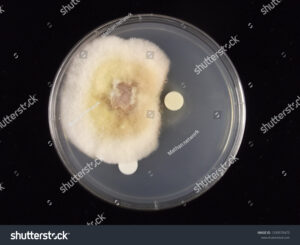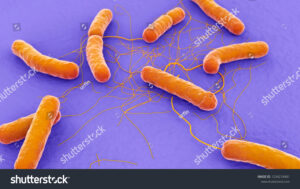Bacillus is the Latin word which means “stick”. It is gram positive, rod or cylindrical shaped bacteria. The word Bacilli used as plural form.
Bacillus species can be obligate aerobes (strictly depend on oxygen) and facultative anaerobes (in stressed conditions can live in the absence of oxygen). In the presence of oxygen, the Bacillus bacteria will give catalase positive reactions.
we will going to discuss the bacillus examples
- Bacillus subtilis
- Bacillus cereus
- Bacillus anthracis
- Bacillus amyloliquefaciens
- Bacillus thuringiensis
Structure of Bacillus bacteria
The cell wall of bacteria is tough which became barrier between bacteria and environment. The cell wall also helps to maintain the shape of the bacteria i.e. rod shape and also maintained its shape when the pressure applied by cell’s turgor. The Bacillus cell wall is of teichoic and teichuronic acid in nature. The bacteria generate and maintain its shape due to actin like cytoskeleton. The bacteria formed one endospore per cell. These spores are resistant to cold, heat, desiccation, radiation and disinfectants.

Isolation and identification
Easiest way to isolate the Bacillus sp. is by taking non-sterile soil the test tube dissolved in the water by shaking further placed in the melted mannitol salt agar and incubation at the room temperature for minimum one day. The Bacillus cells appears as rod shaped and oval endospores are observed at one end making them bulge when observed under the microscope.
Characteristics of the Bacillus species
Colony characters–
the colony of the bacteria are medium in size, whitish in color and convex in shape.
Morphological characters–
the shape of the bacteria cell is of rod or cylindrical type.
Physiological characters-
the bacteria are motile in nature and can grow at 6.5% NaCl (Sodium Chloride).
Biochemical characters–
it is gram positive, catalase positive and oxidase negative. It gives positive test results of methyl red, nitrate reductase, – galactosidase.
Hydrolysis reaction–
the bacteria will take part in hydrolysis of gelatin, aesculin, casein, tween 40, tween 60 and tween 80.
Here we will discuss about the species of Bacillus bacteria that have industrial significance.
Bacillus amyloliquefaciens
this species is the source of Bam HI type of restriction enzyme.This is also the synthesizer of a natural antibiotic protein barnase. Barnase is a type of ribonuclease that forms tight complex with its intracellular inhibitor plantazolicin and barstar, an antibiotic against B. anthracis.
It is used in aquaculture, agriculture and hydroponics to fight against root pathogens like Pythium, Alternaria tenuissima, Ralstonia solanacearum and Fusarium and improve to salt stress tolerance. They also have ability of root colonization quickly.
Alpha- amylase obtained from B. amyloliquefaciens is used in hydrolysis of starch. it is also catalyzes the breakdown of protein in a similar way to trypsin by subtilisin.

B.amyloliquefsciens from Shutterstock
Bacillus subtilis-
it is also known as grass bacillus or hay bacillus. It is gram positive, catalase positive bacteria commonly found in gastrointestinal tract of ruminants, marine sponges, humans and soil. Bacteria can form a tough and protective endospore that allowing it survive in the extreme environments.
B. subtilis is considered a model organism which helpful to study bacterial chromosomal replication and differentiation of cell.
B. subtilis used as immunostimulatory agent to treat the urinary tract and gastrointestinal infections when there was no antibiotics discovery. In the 1950s, it is used an alternative medicine which on digestion found to stimulate the broad-spectrum immunity that includes activation of secretion of specific antibodies IgA, IgM and IgG. It is also helpful in development to cytotoxicity by the release of CpG dinucleotide that induce interferon IFN-alpha/ IFN-gamma producing the activity of cytokines and leukocytes.
A strain of B. subtilis formerlly known as Bacillus natto used in production of Japanese food natto.
Now a days, Bacillus subtilis used as model organisms to study the features of gram-positive bacteria. It I also helpful the study the basic principle and mechanisms leads to the formation of endospore durability. It is used to produce many enzymes like amylase and proteases due to its property of fermentation. B. subtilis is used as a soil inoculant in agriculture and horticulture.
In the gas sterilization procedures, it is used as “indicator organisms” to ensure the completion of sterilization process. It also acts as a byproduct fungicides. It is also in some cases that it helpful in production of saffron by increasing corm growth and stigma biomass yield.

Bacillus thuringiensis (Bt)-
it is gram positive and soil dwelling bacteria, commonly used as biological pesticide worldwide. Many Bt strains produce crystal protein during sporulation called delta endotoxin, having insecticidal properties. Due to its insecticidal property, it is used as insecticides more recently in genetically modified crops by using Bt genes such as in Bt corn crops.
As an insecticidal mechanism, cry protein produced by the bacteria binds to the specific receptors on the mid gut membrane (epithelial) cells of targeted insects which result in rupture. Other organisms like humans, non-targeted insects and other animals lacks the receptor for the cry protein in their gut so they cannot be affected by this protein and in the same way not affected by Bt. Now a days these insecticides often applied as a liquid spray under the trade name DiPel and Thuricides. Because of specificity of these insecticides they are environment friendly.
Use of Bt gene in plant engineering
The first genetically modified crop is tobacco by the Belgian company Plant Genetic Systems by expressing cry genes from B. thuringiensis. Bt tobacco crop plant contain delta endotoxin.
- The first genetically modified crop is tobacco by the Belgian company Plant Genetic Systems by expressing cry genes from B. thuringiensis. Bt tobacco crop plant contain delta endotoxin.
Bacillus anthracis
it is gram positive, rod shaped bacteria, obligate pathogen which cause a deadly disease anthrax. This bacteria infection is zoonosis in nature, i.e. transmitted from animals to animal or humans. Robert Koch discovered it as first pathogen bacteria. Because of its resilience (capacity of bacteria to recover its shape and sizes after deformation caused by the stress) of the endospore, this is one of the most popular biological weapons. If the infection caused by this bacterium is untreated, found to be deadly. The anthrax infection is indicated by black necrotic (eschar) and inflammatory lesion. The sore appears on the neck, arms, hands or face. The deadly symptoms include chest discomfort, diaphoresis, body aches and flu-like fever.
Bacillus cereus–
It is gram positive, rod shaped, motile, spore forming, facultative anaerobes bacteria found in soil, marine sponges and food. The word ‘cereus’ meaning “waxy” in Latin, refers to the colony’s appearance grown on the blood agar. Some strains are harmful to human, cause foodborne illness while other can be beneficial act as probiotics for animals.

Also Read:
- Nucleic acid monomer
- Glycolipid functions
- Pome fruit examples
- Eukaryotic cells vs bacterial cells
- Reverse transcriptase its basic mechanism
- Vascular plants examples
- Water movement through cell wall
- Do chloroplasts have dna
- Is enzyme inhibited
- Do prokaryotes have centrioles 2
Hi..I am Tanu Rapria, I have completed my Master’s in Biotechnology. I always like to explore new areas in the field of Biotechnology.
Apart from this, I like to read, travel and photography.
